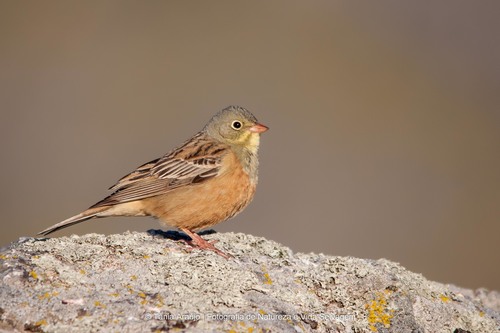
Ortolan Bunting
The Ortolan Bunting (*Emberiza hortulana*) is a small, seed-eating bird belonging to the bunting family. It is known for its distinctive, melodic song and, unfortunately, its historical use in French cuisine, where it was considered a delicacy. This practice, now largely illegal, has significantly contributed to the species' decline. Ecologically, the Ortolan Bunting plays a role in seed dispersal and insect control within its agricultural and grassland habitats. Culturally, it holds a dark significance due to the traditional method of its preparation for consumption, which involved force-feeding and drowning in Armagnac.
16-17 cm
Length
23-29 cm
Wingspan
Least Concern
Conservation Status
Distribution
The Ortolan Bunting breeds across most of Europe and western Asia. It is a migratory species, wintering in sub-Saharan Africa. Its range extends from Scandinavia in the north to the Mediterranean in the south, and from France in the west to parts of Central Asia in the east. It migrates via distinct routes, often congregating at specific stopover sites.
Lifespan
The average lifespan in the wild is estimated to be around 2-3 years, though some individuals may live longer.
Ortolan Bunting's Habitat
Habitat Types
Open farmland, Grasslands, Cultivated areas with hedges and scattered trees, Steppes
Climate Zones
Temperate, Mediterranean, Continental
Adaptations
The Ortolan Bunting prefers open habitats with low vegetation, allowing for easy foraging on the ground. Its relatively short, conical bill is well-suited for cracking seeds, its primary food source.
Variations
While several subspecies have been proposed, there is ongoing debate about their validity. Some regional variations in plumage and song may exist, but further research is needed.
Appearance
Breeding Plumage
Breeding males have a distinctive olive-green head and breast, a yellow throat and moustachial stripe, and chestnut-brown upperparts. Non-breeding males and females are duller, with streaked brown upperparts and less distinct head markings.
Seasonal Feather Changes
Plumage becomes more vibrant during the breeding season, particularly in males. After breeding, birds molt into a duller, non-breeding plumage.
Sex Based Plumage Differences
Males are more brightly colored than females, especially during the breeding season.
Notable Features
Olive-green head (in breeding males), Yellow throat and moustachial stripe, Chestnut-brown upperparts, Streaked underparts
Diet and Feeding
Primary Foods
Seeds, Grains, Insects (especially during breeding season), Small invertebrates
Foraging Behavior
The Ortolan Bunting primarily forages on the ground, pecking at seeds and small invertebrates. It often forages in small flocks, especially outside the breeding season.
Specializations
Its strong, conical bill is adapted for cracking seeds efficiently.
Seasonal Diet Variations
The diet shifts towards a higher proportion of insects during the breeding season, providing protein for growing chicks. In winter, the diet consists mainly of seeds and grains.
Behavior
Social Structure
Ortolan Buntings are generally solitary or found in pairs during the breeding season. Outside the breeding season, they form small flocks, sometimes mixed with other bunting species.
Communication
A distinctive, metallic song delivered by males, Various call notes, including a soft 'tsip' and a harsher 'chup', Visual displays, such as raising the head feathers during territorial disputes
Migration
Ortolan Buntings are long-distance migrants, traveling from their European and Asian breeding grounds to sub-Saharan Africa for the winter. They migrate at night, often in large flocks. The exact routes and stopover sites are still being studied.
Territorial or Group Behaviors
Males defend territories during the breeding season, singing to advertise their presence and chasing away intruders. Outside the breeding season, they are more gregarious and form flocks.
Conservation
Threats
Habitat loss due to agricultural intensification, Illegal hunting and trapping (particularly in France), Pesticide use, Climate change (affecting migration and breeding success)
Protection Programs
EU Birds Directive (prohibits hunting and trapping in most of Europe), Some national conservation programs focused on habitat restoration, Monitoring of populations and migration routes
Local National Laws
Hunting and trapping are illegal in most European countries, but enforcement remains a challenge in some areas. France has specific regulations, with periods of permitted capture historically, now largely banned.
Population Trend
Decreasing
Population Estimates
The global population is estimated to be between 2.8 - 9.4 million mature individuals, but the range is very wide.
Interesting Facts
The Ortolan Bunting was traditionally considered a delicacy in French cuisine.
Birds were captured, force-fed, and drowned in Armagnac before being cooked and eaten whole.
The traditional method of preparing Ortolan Buntings involved covering one's head with a napkin while eating.
This was said to be either to hide the act from God or to enhance the aroma.
Ortolan Buntings migrate at night.
This helps them avoid predators and navigate using the stars.
The song of the Ortolan Bunting is said to have inspired composers.
Some believe the opening notes of Beethoven's Fifth Symphony were inspired by the bird's song.
Faqs about Ortolan Bunting
Is it legal to eat Ortolan Buntings?
It is illegal to hunt, trap, or trade Ortolan Buntings in most European countries, including France, under the EU Birds Directive. However, illegal trapping still occurs.
Why are Ortolan Bunting populations declining?
The main threats are habitat loss due to intensive agriculture, illegal hunting and trapping, and the use of pesticides.
What can be done to help Ortolan Buntings?
Conservation efforts focus on habitat restoration, promoting sustainable farming practices, enforcing anti-poaching laws, and raising public awareness.
Where can I see Ortolan Buntings?
During the breeding season (spring and summer), they can be found in open farmland and grasslands across Europe and western Asia. In winter, they migrate to sub-Saharan Africa.
Copyright @ Nature Style Limited. All Rights Reserved.
 English
English